MARKET OVERVIEW
The Global Branded Generics market is envisaged to grow tremendously. This is a very large sector, emerging within the realm of the pharmaceutical industry, will forever change the face of drug penetration and branding strategies across different geographical regions. It concentrates on pharmaceutical products that are chemically identical to their off-patent counterparts, but which will be closely marketed under a proprietary brand. The products thus will be in a special position-up between premium ones and cheap generics-and their continual existence will be strictly justified through regional healthcare dynamics and prescribing practices.
The Global Branded Generics market will be a strategic alternative as healthcare systems across the world are looking for treatment options that are affordable and cost-effective but do not compromise on quality. These medicines would help pharmaceutical companies stretch the commercial life of agent molecules whose patents have already expired and reintroduce them with a branding strategy that resonates in both mature and emerging economies. Branding will enable manufacturers to differentiate their products in a highly competitive environment while ensuring a perception among patients that brand means quality.
Differentiated from the traditional generics which were solely considered based on price, branded generics tended to use consumer trust and recognition of physicians' trust. The approach would find a more singular manifestation in the context of fragmented healthcare infrastructure or where regulatory pathways permit brand perception to sway generic drug distribution. This means henceforth that The Global Branded Generics market would thus respond to both economic constraints and behavioral frameworks dictating pharmaceutical consumption across regions.
Pharmaceutical companies are bound to use branded generics to stay in the limelight in therapeutic areas where patent exclusivity has expired. In cardiovascular, anti-infective, and some central nervous system disorders, these products will be mostly marketed. The Global Branded Generics will provide them the means to substantiate the efficacy of their products while retaining some form of branding in those regions, as where physicians build strong opinions about drugs based on manufacturer names. Global Branded Generics will thus equate to a pricing mechanism and also a tactical brand decision, based upon brand recognition cultivated over years by the traditional pharmaceutical industry.
The regulatory environment will continue to determine how these products will be regulated and marketed. In some situations, branded generics will, for multinational companies, represent a gateway opportunity to establish a foothold without incurring the investment costs required for the commercialization of new chemical entities. Regulate the entry of national drug policies and healthcare insurance models at the level that governs physicians' and pharmacists' interactions with these products, thereby leading to the stimulation of different market environments across Latin American, Asia-Pacific, and Eastern European countries. Thus, the Global Branded Generics market shall be automatically delineated.
Global Branded Generics market is estimated to reach $27,691.67 Million by 2032; growing at a CAGR of 8.4% from 2025 to 2032.
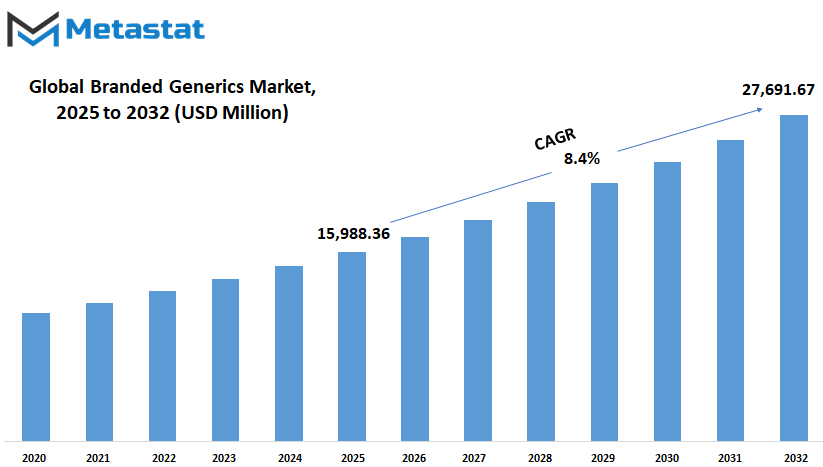
GROWTH FACTORS
Several factors are touted to promote the Global Branded Generics market, now on a good course for development onto its expected futures. One of the market bulwarks, in fact, has to do with the increasing demand for cheap medicines. With healthcare costs having soared to new heights, patients and physicians alike are looking for alternatives that will provide the same therapeutic benefit as branded drugs but at far less cost. Branded generics, which are generics of brand-name drugs, offer a perfect solution, providing the same high-quality treatment at a reasonable price. Thus, there is a growing demand for branded generics, especially in regions where healthcare expenditure is an issue.
Another key market driving factor is patent expiry for blockbuster drugs. Once a patent expires, a drug may be subject to different manufactures making generics, thus greatly amplifying the reduction in the cost of these drugs. The entry of branded generics to market permits consumers to access those medically needed drugs at cheaper prices, thus ensuring that these drugs bear a certain degree of quality and brand awareness. This transition from patent-protected brand-name drugs to generics has been a huge market-driving force with a huge avenue for growth.
However, there are certainly barriers for market growth in any area. One big hurdle is the cut-throat competitive nature of the generic drug market. Since many companies enter the market to capitalize on the drug patent expiration, competition becomes too intense, creating price pressures. Manufacturers have to cut down prices or else lose share, which can heavily affect profit margins and create financial vulnerabilities, especially for the smaller players in the game.
Regulatory hurdles and delays in the approval of generic drugs can act as deterrents to market growth. The generic drug approval process under regulatory authorities such as the FDA can be protracted and complicated. These delays can hinder a generic drug from entering the market, hence minimizing its chances of reaching the hands of the consumers and damaging the reputation of the overall branded generics market
Looking ahead, opportunities for growth would present themselves in the expansion of branded generics in emerging markets. The demand for cheap medicines shall exponentially rise as delivery of health care improves in the Asia-Pacific, Africa, and Latin America regions. The growing middle class and evolving healthcare infrastructure in those regions will only enhance the allure of branded generics. The combination of affordability and brand confidence will drive the uptake of branded generics, thus giving way to profitable opportunities for growth in the near future.
MARKET SEGMENTATION
By Drug Class
The branded generics market worldwide should see heavily expected growth over the next number of years due to the increase in healthcare needs, rising costs of branded drugs, and advancement of technological infrastructure in pharmaceuticals. Such patients and healthcare providers seeking lower-cost options to branded medications will find bright prospects in branded generics. This transformation has been driven by an increasing demand for effective yet affordable treatment both in developed and in developing markets.
Forward-looking observations into the future are likely to predict an increase in the number of drug classes available as branded generics. Alkylating agents used in cancer treatment will continue to be in demand as a significantly predictable demographic segment will account for increased cancer diagnoses worldwide. Chemotherapy requires these agents to be widely used, and the market for branded generics at this level will expand due to increased awareness and access to treatment.
Another important drug class is represented by antimetabolites, the application of which is in the treatment of several cancers, as well as autoimmune diseases. The number of afflicted individuals around the globe continues to be in the millions, so demand for affordable branded generics under this category will rise. There has also been an increase in the branded generics market from hormonal therapies, for breast and prostate cancers, as well as for people with hormone imbalances. These will be available on a more significant scale as health systems seek cost-effective solutions.
In addition, there would be a consistent supply of demand for anti-hypertensive drugs that treat high blood pressure, as hypertension causes problems for a lot of old people. The market for branded generics under this class will continue to grow because healthcare systems are now more focused on chronic conditions. Lipid-lowering drugs would also demonstrate continued strong demand, especially for countries that have an aging population, which is very important in controlling the levels of cholesterol and reducing the risks of cardiovascular diseases.
Anti-depressants, anti-psychotics, and anti-epileptic drugs are all likely to experience further growth in the branded generics market as demand increases due to a growing population of individuals suffering from mental health issues and neurological disorders. As society generally becomes more aware that mental health is health, and with decreasing stigma about such illnesses, the effect in terms of increased need for affordable branded generics in these classes would happen.
In even more distant futures, other classes of drugs will likely add to the contributions to the Global Branded Generics market. Their diversity and accessibility will be crucial in addressing health care demand across countries and improving access to life-saving treatments. The extension of this market will continue to provide more affordable alternatives to expensive branded drugs and thus benefit both patients and health systems worldwide.
By Application
On the path of constant growth, the Global Branded Generics market will be driven further by the high demand for affordable and effective medicines-all these as the world is revealing its increasing need for health care solutions. Considering branded generics, these are defined as medications sold under a different name but in a similar formulation and typically at a lower price as compared to brand-name counterparts, thus they can be better understood as one of the increasingly significant aspects of healthcare. The global branded generics market is further subdivided into various applications, each fulfilling an important role in treating a wide variety of conditions.
Oncology is one of the major applications added to the Global Branded Generics market. Cancer remains one of the leading cause deaths in this world, and costs are skyrocketing. Consumers help themselves choose branded generic options that afford them the same therapeutic benefits without incurring costs that resemble those of the originals. As cancer therapy further evolves, the availability of oncology treatments in the branded generics category will increase, enabling more lives to benefit from saving therapies.
Branded generics will gain entry in another major segment- cardiovascular diseases. Heart disease and cardiac ailments accounted for several lives, apparently bulk in number, suffering during a short span of time in many places around the globe and in need of sustained medication. The longer society ages, the higher the integration of cardiovascular illnesses rises, by branded generics; to certainly help in access to superior quality medicines at an affordable cost by people. Again, this will continue to thrive because it is a very important part of cost containment for the healthcare system providing yet maintaining necessary treatment.
Another major domain opening up for branded generics is neurological diseases such as Alzheimer's, Parkinson's, and epilepsy. These chronic conditions usually require specialized medications; hence, they are expensive. This makes branded generics to be an attractive alternative. With continuous research and development, the number of such available formulary products may increase, thus providing cheaper alternatives for patients suffering from neurological disorders.
The other growing segment of branded generics will be the treatment of gastrointestinal diseases and dermatological conditions. The promotion of generic drugs, particularly for those treatments, is expected to continue increasing especially with the diagnosis of more digestive disorders and skin health issues. These medicines will eventually become essential, and more and more patients will benefit from them without financial consumption related to brand-name drugs.
The use of branded generics will also thrive in acute and chronic pain treatment. Pain management is an integral aspect of healthcare; thus, with chronic pain conditions on the increase, demand for medicines affordable enough will grow. Branded generic medicines in this area will help ensure pain relief becomes accessible to a wider population.
By Route of Administration
The Global Branded Generics market shows a steady and optimistic forecast as it continues to grow. The most important growth factors are the methods of drug delivery or administration. Increasingly associated health care needs and new drug developments will contribute to the demand for branded generics through various methods as topical, oral, parenteral, etc. Each of the mentioned routes of administration will likely forecast and influence the future market scenario differently.
The most popular administrating method for the branded generics market remains oral medicating. It hasn't changed in many centuries; pills and tablets will always be the delivery method for very many medications. The demand for oral branded generics would probably increase as more individuals turn to the use of oral medication either for management of chronic diseases or for preventive care. In fact, this is the best route for an ambulatory patient and most healthcare providers because it is safe, cost-effective, and easy to administer. Most importantly, these offer an excellent opportunity because of an increasing emphasis on patient adherence to their respective regimens.
Topical medications include another segment of the branded generics market. Creams, ointments, and gels are frequently used to treat specific conditions affecting the skin, such as skin infections, wounds, or even chronic ailments regarding the skin. With dermatological problems increasingly proliferating, there will be a sharper focus on making affordable branded generics for such conditions. The topical route provides the practical solution, as it can usually be applied directly to the skin, thus providing quicker and possibly better relief while causing fewer side effects than other forms of administration. This area is likely to find patients looking for accessible treatments for their skin conditions.
The parenteral novel route, including injections or infusions, will have a part in the future of the branded generics market. With biotechnology advances and a surging incidence of chronic diseases like diabetes and cancer, the role of injectable generics is becoming prominent. Having sophisticated production processes, such medicines will evolve higher technology and availability for parenteral branded generics. Demands for these treatments will rise with the population's greying, and yet branded generics will facilitate access to cheaper sources for such treatments compared to the branded originals.
Lastly, the methods of administration will offer some wealth to the market through inhalers and transdermal patches that could also be included. As advancements in healthcare take place, new ways of administering these medicines shall evolve, opening avenues through which branded generics can widen their scope further. These will still serve specific patient needs, such as those with respiratory conditions, hormone replacement therapies, or pain management.
By Distribution Channel
The Global Branded Generics market is likely to witness considerable growth in the next couple of years mainly due to an increasing demand for economical medicines of high quality. The healthcare sector has gained momentum in many countries, particularly in highly populous nations with expanding medical infrastructure; hence, the branded generics market shall continue to flourish. The very distribution channels by which these medicines are being made available are likely to undergo considerable changes, affecting the entire movement of branded generics to consumers in all parts of the world.
Through hospital pharmacies, there will continue to be distribution for branded generics. Hospitals typically use up a great deal of medications for diverse patient conditions. Increasingly, therefore, hospitals are using branded generics as a cost-efficient alternative to putting strains on their budgets while granting services to patients to acquire clinically relevant medications. The role of hospital pharmacies for the distribution of branded generics is expected to increase due to a boost in demand for healthcare services in the emerging markets.
The retail pharmacy sector is considered another key contributor to the growth of the Global Branded Generics market. It is the first point of access to the general population for any medication needed to alleviate symptoms of health care. Now that both health professionals and patients are accepting more branded generics, this will lead to the rising demand for these products via retail pharmacies. As consumers continue to learn about branded generics, actively searching for more affordable alternatives for long-term treatment will give retail pharmacies a good running chance to meet their demands.
As more individuals are shifting their needs toward the online platform, online pharmacies are expected to grow into a very vital distribution channel. Since the convenience of online shopping and a wider choice of price comparisons and bargains are attractive features to some consumers, many of them might prefer using online pharmacies. Also, online pharmacies still have an edge to reach patients in far-off places with limited access and availability to traditional pharmacies. As the penetration of the internet widens, online pharmacies would be able to deliver branded generics even more to the global market, thus contributing toward an affordable and accessible healthcare system.
Thus, the Global Branded Generics market is set to witness immense expansion due to the adaptability of the distribution channels to the changing needs of the market. This growth will enhance patient access to affordable medications across multiple environments.
|
Forecast Period |
2025-2032 |
|
Market Size in 2025 |
$15,988.36 million |
|
Market Size by 2032 |
$27,691.67 Million |
|
Growth Rate from 2025 to 2032 |
8.4% |
|
Base Year |
2024 |
|
Regions Covered |
North America, Europe, Asia-Pacific, South America, Middle East & Africa |
REGIONAL ANALYSIS
The Global Branded Generics market is anticipated to trail through the rising demand world over in every possible region. For instance, branded generics refer to medications manufactured without considering their innovator counterpart and sold under their chemical nomenclature by companies different from the innovator firm. In comparison to branded medicines, these drugs usually render identical therapeutic benefits at relatively lower costs. Such role of branded generics would, however, be emphasized the more wherever healthcare systems around the globe become pruned to make access cheaper and possible in-terms of availability. Geographically, the market is eclectic in itself; every region has specific opportunities and challenges to offer.
The North American-branded generics market will continue to grow because the United States, Canada, and Mexico drive it. The U.S. has a huge population in which healthcare services are highly demanded. The more the increase in healthcare costs, the more patients and health insurers turn to branded generics, as they prove to be more affordable. Likewise, Canada and Mexico are coming up with improvements in branded generics, focusing on health access without costing much. With these rising awareness levels on the objective cost savings these medications offer, so will they increase in demand in North America.
Europe holds quite an important position in the context of the market. Countries like the UK, Germany, France, and Italy are very much established in the healthcare sector and receiving positive uptake in branded generics. Strong regulations favoring generics in Europe have played a significant role; and this trend will continue. Therefore, as health budgets in Europe remain tight, branded generics will be even more integral to the healthcare landscape-in the form of cost-effective alternatives without compromising on quality. Hence, the rest of Europe, especially the smaller countries, will follow suit as the generic market expands across the continent.
India and China in the Asia-Pacific are possibly going to record the most dynamic growth in branded generics. Both countries, with immense populations and a growing middle class, are taking global proportions in the healthcare market. India is, probably, the most recognized in the segment as far as the thriving pharmaceutical industry is concerned. This problem will get worse as people will have access to more health facilities-branded generics will be increasingly considered. Still in this line-of-growth, China and Japan will record significant developments due to their aging societies making demands for affordable medicines.
South America, particularly Brazil or Argentina, is experiencing an increase in the number of branded generics, as governments are recently looking into ways of providing their citizens with health services that would be affordable. If countries continue to work on strengthening their healthcare systems, the branded generics market will also pay significant attention to this effort. In the Middle East and Africa, countries such as the UAE, Egypt, and South Africa are investing in healthcare infrastructure.
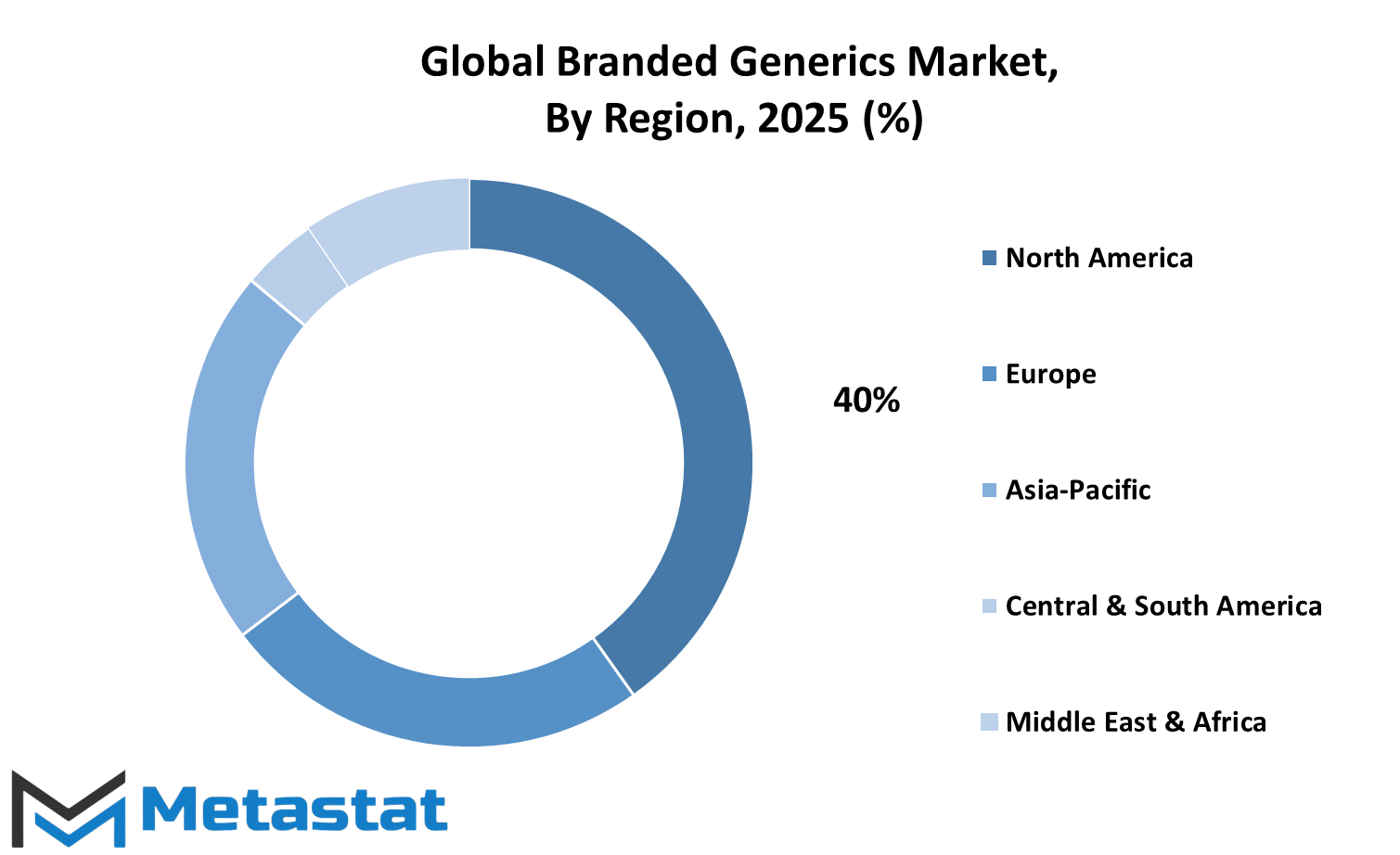
COMPETITIVE PLAYERS
With rivalry among several key players predominating the market, competition will see the future trajectory of the Global Branded Generics market. These are the reputed names well-versed in market dynamics and have been championing innovation. They will act as significant growth drivers, and with their support, the industry will develop with growing trends in both the developed and emerging economies.
A multinational giant in generics, Teva Pharmaceuticals has led in making branded generic medicines available at affordable rates across a multitude of therapeutic areas, with a deep-rooted acknowledgment around the globe. Teva will remain a player with good prospects, in continuous improvement of products and extension into new markets. Also, Sun Pharmaceutical Industries, which has branded generics in its portfolio wide enough for this company to compete fairly, relying on its strong research and development now and in the years ahead.
Alkem Laboratories, another of the important players, has advanced greatly in the enhancement of its presence in global markets. Alkem is familiar with the trade of credible generics, and with healthcare becoming more affordable in the coming days, the company will continue to strengthen its path forward. Lupin Limited will still compete at the forefront with great chances, continuing to expand in different international markets and working toward strategic partnerships and acquisitions to build its product portfolio with a focus on quality generics.
Dr. Reddy's Laboratories has been an important player in the Indian and international markets and will still remain an important part of the landscape. Concentrating on Research, Quality, and Accessibility, Dr. Reddy's is expected to prosper as nations strive to lessen their healthcare burden. This, in conjunction with other players in the field, especially such organizations as Sanofi and Viatris, will see to it that they shape the market of the future to be embraced by generic pharmaceuticals. Sanofi, having a consistent history of introducing innovation in therapeutics, plans to build more generics to supply the increased necessity.
Other significant players such as Cipla Ltd., Pfizer Inc., and Strides Pharma Science hold a significant share of the market and will likely remain competitive by focusing on the quality and affordability of their branded generic products. Aurobindo Pharma and Torrent Pharmaceuticals will play a key role in shaping the future of the industry with their extensive portfolios of generic medicines. Finally, Hikma Pharmaceuticals is growing fast and remains a likely major rival, particularly in markets outside of the U.S.
Such companies will continue to contribute to the innovation and growth of the Global Branded Generics market as they adapt to regulatory changes while seeking to enhance access to medicines and tap into opportunities for entering untouched areas.
Branded Generics Market Key Segments:
By Drug Class
- Alkylating Agents
- Antimetabolites
- Hormones
- Anti-hypertensive
- Lipid Lowering Drugs
- Anti-depressants
- Anti-psychotics
- Anti-epileptics
- Others
By Application
- Oncology
- Cardiovascular Diseases
- Neurological Diseases
- Gastrointestinal Diseases
- Dermatological Diseases
- Acute And Chronic Pain
- Others
By Route Of Administration
- Topical
- Oral
- Parenteral
- Others
By Distribution Channel
- Hospital Pharmacy
- Retail Pharmacy
- Online Pharmacy
Key Global Branded Generics Industry Players
- Teva Pharmaceuticals
- Alkem Laboratories
- Sun Pharmaceutical Industries
- Lupin Limited
- Dr. Reddy’s Laboratories
- Sanofi
- Viatris
- Cipla Ltd.
- Pfizer Inc.
- Strides Pharma Science
- Aurobindo Pharma
- Torrent Pharmaceuticals
- Hikma Pharmaceuticals
WHAT REPORT PROVIDES
- Full in-depth analysis of the parent Industry
- Important changes in market and its dynamics
- Segmentation details of the market
- Former, on-going, and projected market analysis in terms of volume and value
- Assessment of niche industry developments
- Market share analysis
- Key strategies of major players
- Emerging segments and regional growth potential



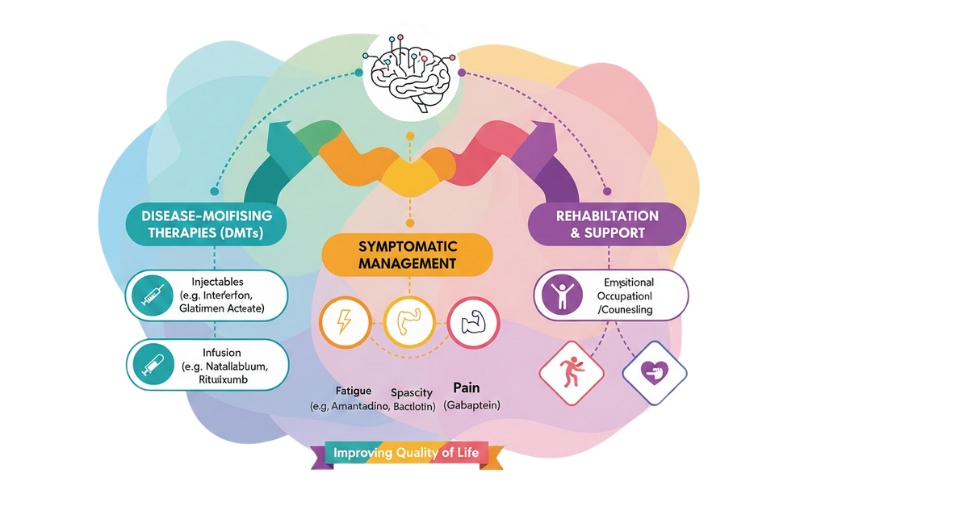
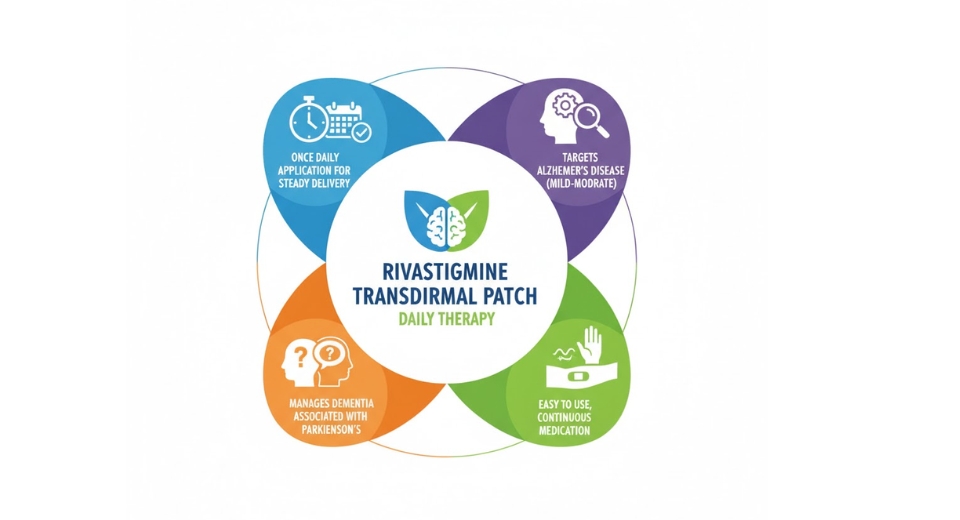
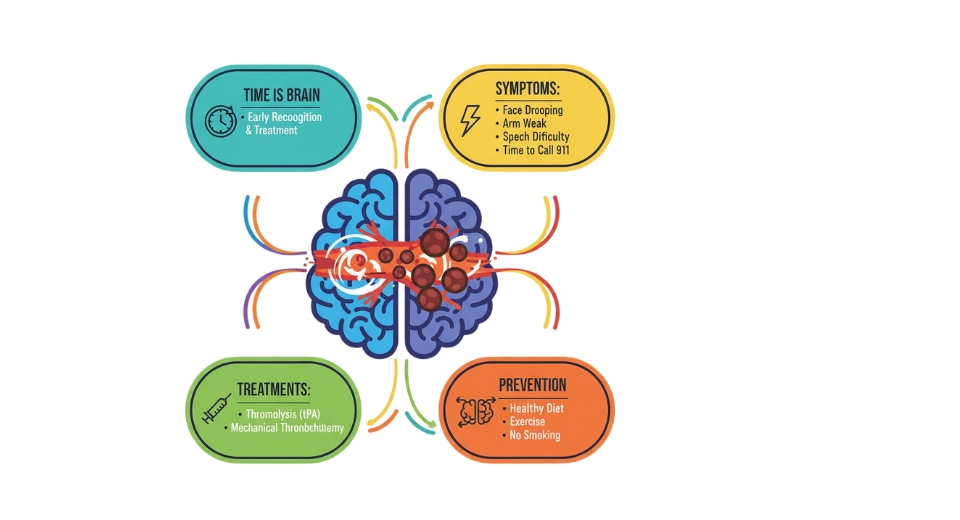
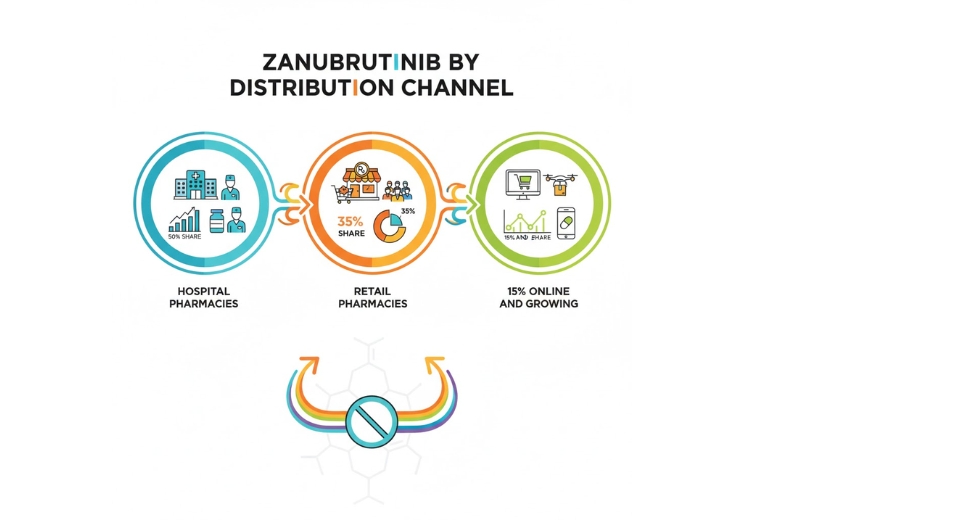

 US: +1 3023308252
US: +1 3023308252






